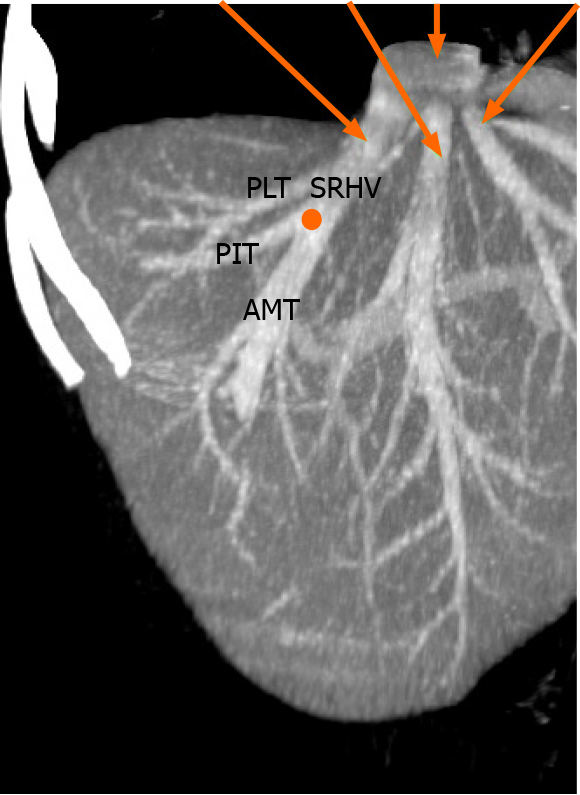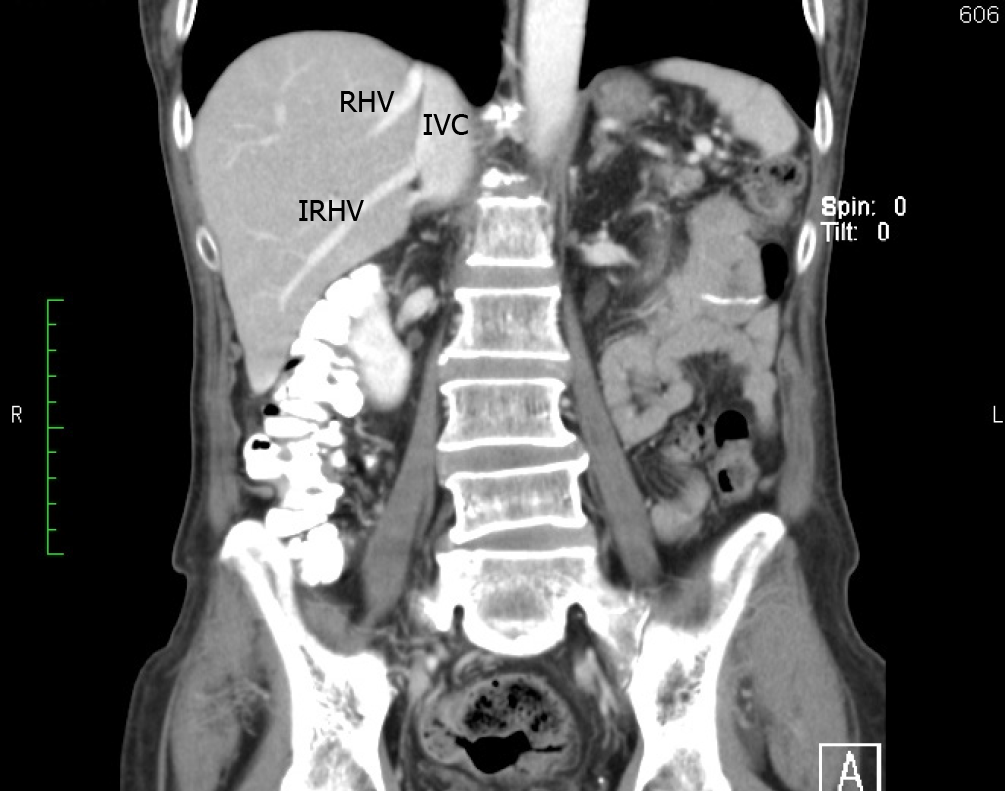Copyright
©The Author(s) 2021.
World J Transplant. Jun 18, 2021; 11(6): 231-243
Published online Jun 18, 2021. doi: 10.5500/wjt.v11.i6.231
Published online Jun 18, 2021. doi: 10.5500/wjt.v11.i6.231
Figure 1 Variations of the right hepatic vein.
In the normal pattern, the left hepatic vein (LHV) runs within the inter-sectional plane between segments II and III, continuing to enter the inferior vena cava (IVC). The middle hepatic vein (MHV) is formed at the union of the left inferior middle (LIM) branch vein and the right inferior middle (RIM) vein branch. It travels cephalad in the mid-plane of the liver to enter the IVC, and receives tributaries from both halves of liver, known as left and right superior middle vein branches (asterisk). The right hepatic vein (RHV) forms at the hepatic venous confluence (orange dot) where two large tributaries, meet: the anteromedial tributary (AMT) that drains segments V and the posterioinferior tributary (PIT) that draining segment VI, meet. The two tributaries join to form the superior RHV that then courses up toward the IVC. A tributary draining segment VII (orange arrow) consistently joins the superior RHV from its posterolateral side.
Figure 2 Variations of the right hepatic vein.
“Classification of the ramifications of the right hepatic vein” reprinted with permission from the Journal of the American College of Surgeons, formerly Surgery Gynecology and Obstetrics. Citation: Nakamura S, Tsuzuki T. Surgical Anatomy of the Hepatic Veins and the Inferior Vena Cava. Surg Gynecol Obstet 1981; 152(1): 43-50. Copyright: Journal of the American College of Surgeons 1981. Published by Journal of the American College of Surgeons[4].
Figure 3 Variations of the right hepatic vein.
Coronal view of reconstructed computed tomography images demonstrating showing that the right hepatic venous confluence (orange) receives posterioinferior tributaries (PITs) from segment VI and anteromedial tributaries (AMTs) from segments V and VIII. It continues cephalad as the superior right hepatic vein (SRHV), that which consistently receives a posterolateral tributary (PLT) from segment VII. The main trunk of the RHV then empties directly into the inferior vena cava (IVC) at the hepatocaval junction. The portal vein (PV) is also visible in this reconstruction.
Figure 4 Variations of the right hepatic vein.
Coronal view of reconstructed computed tomography images demonstrating a proximal venous confluence (orange) that receives the posteroinferior tributaries (PITs) and anteromedial tributaries (AMTs) before continuing cephalad as the superior right hepatic vein (SRHV). The consistent posterolateral tributary (PLT) from segment VII is also seen.
Figure 5 Variations of the right hepatic vein.
Reconstructed coronal computed tomography images with an arrow demonstrating the consistent posterolateral tributary from segment VII (sVII) joining the right superior hepatic vein (RSHV) to form the main right hepatic vein (RHV).
Figure 6 Variations of the right hepatic vein.
Axial computed tomography scan of the abdomen demonstrating a large inferior right hepatic vein (IRHV) entering the inferior vena cava (IVC) at the lower border of the liver. This crosses below the right branch right of the portal vein. RPV: Right portal vein.
Figure 7 Variations the of right hepatic vein.
Coronal reconstruction of a computed tomography scan of the abdomen demonstrating a large inferior right hepatic vein (IRHV) entering the inferior vena cava (IVC) at the lower border of the liver. RHV: Right hepatic vein.
Figure 8 Variations of the right hepatic vein.
Axial computed tomography scan of the abdomen demonstrating a small right middle hepatic vein (arrow) entering the retrohepatic inferior vena cava (IVC). This cut is at the middle of the intrahepatic IVC as evidenced by the absence of main hepatic veins and/or portal bifurcation.
Figure 9 Variations of the right hepatic vein.
Coronal reconstruction of the computed tomography scan of the same patient shown in Figure 5. This image shows the middle right hepatic vein emptying into the retrohepatic inferior vena cava (IVC) < 2 cm from the junction of main right hepatic vein and the IVC.
- Citation: Cawich SO, Naraynsingh V, Pearce NW, Deshpande RR, Rampersad R, Gardner MT, Mohammed F, Dindial R, Barrow TA. Surgical relevance of anatomic variations of the right hepatic vein. World J Transplant 2021; 11(6): 231-243
- URL: https://www.wjgnet.com/2220-3230/full/v11/i6/231.htm
- DOI: https://dx.doi.org/10.5500/wjt.v11.i6.231

















